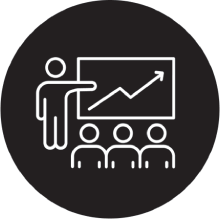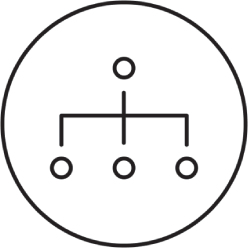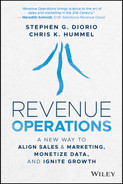CHAPTER 14
Practical Tools to Take Control of Your Revenue Cycle
Our goal in writing this book was ambitious – to teach the next generation of growth leaders a system to steadily drive growth in the twenty-first century.
In the first part of this book we defined Revenue Operations and its impact. In the next, we articulated the six key pillars that make up the management system for growth. Our goal was to help you decide which leadership model works best for aligning marketing, sales, and customer success in your business. We then outlined the building blocks of a Revenue Operating System. Here we provided a practical but durable framework to help you connect the dots across your technology, data, process, and team investments in ways that can help you grow faster at lower cost. This framework can help you prioritize the capital and operating investments you need to make to accelerate growth.
In this final section, we've brought it all together to get you started building your own system of growth. We introduced the concept of Smart Actions and provided you tools and examples to best implement Revenue Operations for your own company.
In chapter 11, we helped you identify a good place to get started on your journey. We outlined six Smart Actions that your organization can take to better align revenue teams, operations, systems, and processes to ignite growth. These represent the most common and financially viable steps the organizations we interviewed were taking. Individually, each action can be piloted, sequenced, and measured to create financially viable and bite-size stairsteps that move your organization through a transformation in ways that are politically, practically, and financially achievable. Collectively, the sum of these steps can yield transformational results. Consider these a place to start. Or use them for inspiration to build Smart Actions of your own.
In chapter 12, we showed you examples of how businesses of all different types are putting these Smart Actions into practice to build systems of growth that address their unique growth challenges.
In chapter 13, we taught you a financial framework that helps you connect these Smart Actions to firm value and financial performance so that you can build the consensus, budgets, and buy-in you need to act and bring your organization with you.
In this final chapter, we provide practical tools to help you and your team to visualize and prioritize the smartest steps you can take in the short, medium, and long term to grow faster and more profitably.
To do this, we have synthesized all of the lessons in this book into a one-page menu of 18 common capabilities that the best organizations are developing to build a system for scalable and consistent growth (see Figure 14.1). This menu is a complete summary of all the best practices and Smart Actions we covered in this book. It may be a good way for you to identify the practices you think will be most useful in your organization. Highlight the ones that make the most sense for your business to explore taking.
The menu expands into a maturity assessment that is structured to help you evaluate how well your current capabilities match up against the best practice in each area. Over the following pages, we have broken down each of the 16 dimensions into four levels of competency. Each level of competency is described in a way that will help you compare it with the current situation at your company. We've numbered them 1–4 to make it easy for you to grade your organization uniformly across these. Try circling the level you think corresponds to your organization.
Once you have graded your organization across the 16 dimensions, think about in which three or four areas you would want to upgrade your capability to the next level. This gives you a rigorous basis for creating a road map for improving your selling approach in ways that lead to more consistent and profitable growth. Each of these incremental steps you prioritize creates the basis for discussing measurable value, what a proof of concept pilot would involve, and whether you can get buy-in and agreement to fund it. Individually, the steps you choose to take should create value or become critical building blocks for more ambitious improvements. Over time they should add up to make a significant impact on growth, profits, and firm value. This road map represents an illustrative and commonsense blueprint for how your organization can sequence and scope the changes involved in commercial transformation.
The assessment gives you a good sense of the most financially attractive places to try to improve. With some additional thought, it is possible to identify the most financially viable ways to “stair-step” your organization toward a more scalable and consistent system of growth. Once you have graded your organization across the 16 dimensions, think about what would be the economic benefits of upgrading your capability to the next level. You can use the list of eight ways Revenue Operations creates financial value from chapter 2 as a guide. For each incremental improvement you consider, ask yourself what is the economic benefit of taking this action? If you answer yes to any of the following eight questions, you are on the right path:
- Will it help to monetize your customer data, digital technology, and channel infrastructure assets by informing selling decisions, optimizing resource allocation, and supporting higher prices and better conversion rates?
- Will it make it simpler, faster, or cheaper to complete selling tasks?
- Will it differentiate the customer experience?
- Will it enable “scalable” technologies that make it much faster and easier to personalize responses and coach sellers in real time?
- Will it motivate the revenue team to build customer lifetime value and net recurring revenues?
- Will it improve visibility into selling performance?
- Will it motivate team selling?
- Will it turn your investments in selling technology into force multipliers that help your revenue team “punch above their weight”?
Once you have zeroed in on the actions that make the most sense, you have the foundation for building the business case for taking that action and justifying the investments involved. You can use the Revenue Value Chain outlined in chapter 13 for inspiration, or build Smart Actions of your own.
The goal of Revenue Operations is to transform the commercial model. The path to getting there is a series of individual actions that incrementally improve revenues or costs or the customer experience. “Business transformation and growth do not rely on a single event but rather a series of well-thought-out operational strategies that are adopted and implemented across a company,” according to Sam Errigo, the Chief Operating Officer of Konica Minolta, who has transformed the company from a hardware business in a declining market to a growing technology services business. “Revenue Operations addresses this concept by providing a practical formula for CEOs and business leaders to generate more consistent and scalable growth that can be executed one step at a time.” We hope this book helps you start the process of pursuing small changes that incrementally improve selling performance today – and that those incremental gains add up to big gains in revenues and profits over time.
| The Revenue Operations Maturity Assessment | ||
|---|---|---|
| A CXO Blueprint for Aligning Sales, Marketing, and Customer Success Teams and Optimizing the Performance of Commercial Processes, Operations, and Assets | ||
| DIMENSION | DEFINITION | CORE COMPETENCIES |

| Top-down leadership to empower and endorse the transformation of the commercial model to unify sales, marketing, and service into one revenue team and become more accountable, data driven, and customer focused. | 1.0 Accountability. Demand full accountability for return on enterprise selling resources, assets, and investments. |
| 2.0 Ownership. Establish a single point of decision-making for the enterprise revenue process, assets, investments. | ||
| 3.0 Change Management. Provide top-down leadership to empower the organization to transform the commercial model. | ||
 | Reconfigure the operations that support growth and enable salespeople to provide coherent, end-to-end management of all customer-facing employees, assets, infrastructure, investments, and the customer journey. | 4.0 Common Purpose. Establish a common purpose across sales, marketing, and customer success teams. |
| 5.0 Organization. Establish cross-functional organizational structures to support salespeople across the enterprise. | ||
| 6.0 Commercial Process. Establish and manage a cross-functional commercial process across the enterprise | ||
 | Redesign the commercial architecture to maximize return on selling assets by improving the speed, visibility, productivity, engagement of frontline selling teams and reducing lower cost to sell. | 7.0 Go-to-Market Strategy. Redesign the go-to-market architecture to improve performance and engagement. |
| 8.0 Sales Force Design. Adjust the sales force design to improve performance, engagements, and costs. | ||
| 9.0 Sales Performance Management. Modify assignments, territories, and incentives to align resources and opportunity. | ||
 | Turning customer engagement and seller activity data into commercial insights that create value and inform decisions, actions, and conversations at the “moments that matter” in the sales process. | 10.0 Data-Driven Selling. Convert revenue data into prescriptive revenue intelligence that informs day-to-day decisions in real time. |
| 11.0 Key Performance Indicators. Establish fact-based reporting analytics, KPI, and dashboards of commercial performance. | ||
| 12.0 Predictive Selling Insights. Use analytics to create better predictions, parameters, and scenarios to inform investment, allocation, and emphasis. | ||
 | Building a common core of commercial capabilities that enable salespeople and maximize the contribution of selling assets and investments to revenue and profit growth outcomes. | 13.0 Enablement and Engagement. Reconfigure the commercial technology infrastructure to better support revenue team enablement. |
| 14.0 Readiness and Development. Reconfigure the commercial technology infrastructure to better support readiness, training, and development. | ||
| 15.0 Revenue Enhancement. Deploy technologies to enhance the lead-to-cash cycle and capture more revenue, margin, and price realization. | ||
 | The strategic management of the commercial data, technology, content, and IP assets to maximize utilization, impact, and return on investment. | 16.0 Content Assets. Establish operational ownership, organization, and deployment of selling content and IP across functions. |
| 17.0 Data Assets. Establish a common architecture and owner to monetize customer data assets | ||
| 18.0 Technology Assets. Establish centralized stewardship and reconfiguration of the commercial technology portfolio across functions | ||
| REVENUE OPERATIONS MATURITY MODEL | ||||
 COMMERCIAL LEADERSHIP | ||||
| Provide top-down leadership to unify sales, marketing, and service into one revenue team and empower management to transform the commercial model to become more accountable, data driven, agile, and customer focused. | ||||
| COMPETENCY | LEVEL 1: BEGIN | LEVEL 2: BASIC | LEVEL 3:ADVANCED | LEVEL 4: BEST-IN-CLASS |
| 1.0 ACCOUNTABILITY. Demand full accountability for return on enterprise selling resources, assets, and investments. | 1.1 Decide on corporate performance goals that define success for all GTM functions and cascade down to customer-facing teams. | 1.2 Define financially valid criteria to prioritize, size, allocate and measure growth resources and capital investment. | 1.3 Create feedback loops to evaluate outcomes, attribution, and performance across sales, marketing, and customer success | 1.4 Establish full accountability for financial outcomes for all growth teams, investment, and infrastructure assets. |
| 2.0 OWNERSHIP. Establish a single point of decision making for the enterprise revenue process, assets, and investments. | 2.1 Assign an individual to evaluate Revenue Operations to identify points of failure and alignment opportunities. | 2.2 Assign an executive to provide cross-functional project management and allocation decisions. | 2.3 Establish a CXO executive to lead commercial transformation and coordinate all revenue team functions. | 2.4 Centralize all decisions about cross-functional resource allocation, infrastructure investment, and commercial architecture. |
| 3.0 CHANGE MANAGEMENT. Provide top-down leadership to empower the organization to transform the commercial model. | 3.1 Create a culture of change by demanding continuous improvement in all commercial processes. | 3.2 Establish a change management office empowered to redefine processes, measurements, and systems from the top down. | 3.3 Establish common purpose with shared goals and incentives for all customer-facing employees. | 3.4 Centralize all operations supporting growth under a CXO with a broad transformation remit and authority. |
| REVENUE OPERATIONS MATURITY MODEL | ||||
|---|---|---|---|---|
 COMMERCIAL OPERATIONS | ||||
| Reconfigure the operations that support growth and enable salespeople to provide coherent, end-to-end management of commercial teams, assets, infrastructure, investments, and processes. | ||||
| COMPETENCY | LEVEL 1: BEGIN | LEVEL 2: BASIC | LEVEL 3:ADVANCED | LEVEL 4: BEST-IN-CLASS |
| 4.0 COMMON PURPOSE. Establish a common purpose across sales, marketing, and customer success teams. | 4.1 Create common definitions of opportunity and performance outcomes for all organizations. | 4.2 Clarify opportunity ownership, priorities, and responsibilities at every stage of the customer journey. | 4.3 Create common measures based on account and pipeline health for all customer-facing employees. | 4.4 Create common incentives based on customer value for all customer-facing employees. |
| 5.0 ORGANIZATION. Establish cross-functional organizational structures to support salespeople across the enterprise. | 5.1 Create a RevOps Center of Excellence to coordinate cross-functional team activities and develop core capabilities. | 5.2 Integrate sales operations and sales enablement with dotted line reporting to centralized operations function. | 5.3 Integrate sales and marketing operations and reporting with dotted line reporting to a central operations function. | 5.4 Fully integrate all revenue operations, enablement, and analytics with solid line reporting to a central operations function. |
| 6.0 COMMERCIAL PROCESS. Establish and manage a cross-functional commercial process across the enterprise. | 6.1 Map the cross-functional commercial process to clarify roles, handoffs, and key points of leverage, scale, customer abrasion, and revenue leakage. | 6.2 Clearly define roles, opportunity definitions and criteria for handoffs and adjudication for all functions. | 6.3 Reengineer the cross-functional commercial process to eliminate friction, handoffs, delays, and revenue leakage. | 6.4 Integrate the systems and data infrastructure that support the cross-functional commercial process to improve visibility, speed, engagement, and productivity. |
| REVENUE OPERATIONS MATURITY MODEL | ||||
|---|---|---|---|---|
 COMMERCIAL ARCHITECTURE | ||||
| Redesign the commercial architecture to maximize return on selling assets by improving the speed, visibility, productivity, engagement of frontline selling teams, and reduce cost to sell. | ||||
| COMPETENCY | LEVEL 1: BEGIN | LEVEL 2: BASIC | LEVEL 3:ADVANCED | LEVEL 4: BEST-IN-CLASS |
| 7.0 GO-TO-MARKET STRATEGY. Redesign the go-to-market architecture to improve performance and engagement. | 7.1 Assess the go-to-market strategy to quantify opportunities to capture more share and opportunity. | 7.2 Refine customer targets based on more precise data-driven signals of intent, win probability, fit, and potential. | 7.3 Refine coverage to reflect the impact of new roles, teamwork, and transaction automation and migration. | 7.4 Refine and agree upon market segmentation supported by more precise algorithmic models of opportunity. |
| 8.0 SALES FORCE DESIGN. Adjust the sales force design to improve performance, engagements, and costs. | 8.1 Assess the sales force design to quantify opportunities to improve performance, margins, and customer lifetime value. | 8.2 Redesign the sales force emphasis to rebalance product, engagement, and activity priorities to optimize performance, margins, and customer lifetime value. | 8.3 Redesign sales force segmentation to clarify roles of lead generation, specialists, and success to optimize opportunity realization, customer lifetime value, and cost to sell. | 8.4 Redesign sales incentive compensation to create common purpose and focus on customer value across functions. |
| 9.0 SALES PERFORMANCE MANAGEMENT. Modify assignments, territories, and incentives to align resources and opportunity. | 9.1 Audit the assumptions underlying territory definitions and quota assignments to ID ways to better align resources with opportunity. | 9.2 Redefine territory boundaries and quota assignments based on more precise data-driven inputs to reflect changes in business model, automation, selling cadence, engagement mix, and customer behavior. | 9.3 Automate the TQP process to improve input parameters, collaboration, scenario development, and update cycles. | 9.4 Align incentives across sales, marketing, and customer experience functions to establish common purpose and focus on customer lifetime value. |
| REVENUE OPERATIONS MATURITY MODEL | ||||
 COMMERCIAL INSIGHTS | ||||
| Turning customer engagement and seller activity data into commercial insights that create value and inform decisions, actions, and conversations at the “moments that matter” in the sales process. | ||||
| COMPETENCY | LEVEL 1: BEGIN | LEVEL 2: BASIC | LEVEL 3:ADVANCED | LEVEL 4: BEST-IN-CLASS |
| 10.0 DATA-DRIVEN SELLING. Convert revenue data into prescriptive revenue intelligence that informs day-to-day decisions in real time. | 10.1 Integrate customer engagement and sales activity data to support coaching and guidance of revenue teams. | 10.2 Enable real-time guidance across revenue teams based on core customer engagement and seller activity data sets. | 10.3 Enable measures that trigger actions to improve the customer experience at every stage of the cross-functional commercial process. | 10.4 Enable real-time guidance across revenue teams. |
| 11.0 KEY PERFORMANCE INDICATORS. Establish fact-based reporting analytics, KPIs, and dashboards of commercial performance. | 11.1 Establish and agree upon a single KPI dashboard that defines desired outcomes and leading indicators of success with sales, marketing, and customer success leadership. | 11.2 Create data-driven measures of customer lifetime value, account health, seller performance, and opportunity potential. | 11.3 Develop KPIs to measure the performance of the end-to-end commercial process across functions. | 11.4 Create common incentives across functions based on customer lifetime value, cost to sell, and key selling activities. |
| 12.0 PREDICTIVE SELLING INSIGHTS. Use advanced analytics to create better predictions, parameters, and scenarios to inform investment, allocation, and emphasis. | 12.1 Establish a center of excellence for developing predictive insights and advanced modeling capabilities. | 12.2 Develop analytics capabilities to predict opportunity value, intent, win probability, fit, and coverage difficulty. | 12.3 Develop predictive analytics capabilities to create more accurate sales forecasts and pipelines. | 12.4 Develop affective analytics capabilities to assess customer sentiment to build empathy and trust in customer conversations. |
| REVENUE OPERATIONS MATURITY MODEL | ||||
 COMMERCIAL ENABLEMENT | ||||
| Building a common core of commercial capabilities that enable salespeople and maximize the contribution of selling assets and investments to revenue and profit growth outcomes. | ||||
| COMPETENCY | LEVEL 1: BEGIN | LEVEL 2: BASIC | LEVEL 3:ADVANCED | LEVEL 4: BEST-IN-CLASS |
| 13.0 ENABLEMENT AND ENGAGEMENT. Reconfigure the commercial technology infrastructure to better support revenue team enablement. | 13.1 Audit the revenue technology portfolio to ID ways to improve utilization, productivity, return on assets, and the seller experience. | 13.2 Integrate sales enablement solutions into a digital selling platform to improve speed, engagement, and time focused on the customer. | 13.3 Integrate the sales readiness, enablement, and engagement road map to improve speed, engagement, productivity, and accountability. | 13.4 Fully integrate sales enablement, readiness, and engagement to support data-driven guided selling and prescriptive insights in real time. |
| 14.0 READINESS AND DEVELOPMENT. Reconfigure the commercial technology infrastructure to better support readiness, training, and development. | 14.1 Audit the learning and development technology portfolio to ID ways to improve visibility, speed to ramp, skills, coaching, and reinforcement. | 14.2 Integrate the learning and development technology portfolio into an integrated and closed-loop process that provides feedback, reinforcement, and visibility into seller activity and compliance. | 14.3 Integrate the sales readiness, enablement, and engagement road map to improve seller ramp, readiness, skills, and accountability. | 14.4 Fully integrate sales enablement, readiness, and engagement to support data-driven coaching at scale in real time. |
| 15.0 REVENUE ENHANCEMENT. Deploy revenue enhancement technologies to enhance the lead-to-cash cycle and capture more revenue, margin, and price realization. | 15.1 Audit CPQ and fulfillment tools to save time, enhance the customer experience, and reduce revenue, price, and margin leakage in the lead-to-cash cycle. | 15.2 Centralize the management and administration of CPQ and fulfillment tools across functions to maximize adoption and impact. | 15.3 Integrate the road map to CPQ and fulfillment tools to accelerate the lead-to-cash cycle, reduce leakage, and optimize price. | 15.4 Evolve revenue enhancement capabilities to support one-to-one personalization of pricing, proposals, and onboarding at scale. |
| REVENUE OPERATIONS MATURITY MODEL | ||||

COMMERCIAL ASSET MANAGEMENT | ||||
| The strategic management of the commercial data, technology, content, and IP assets to maximize utilization, impact, and return on investment. | ||||
| COMPETENCY | LEVEL 1: BEGIN | LEVEL 2: BASIC | LEVEL 3:ADVANCED | LEVEL 4: BEST-IN-CLASS |
| 16.0 Content Assets. Establish operational ownership, organization, and deployment of selling content and IP across functions. | 16.1 Organize all cross-functional readiness, validation, playbook through leadership and product content using a common architecture and taxonomy. | 16.2 Establish a single source of truth for content based on a common taxonomy and architecture to support enablement, readiness, and response management. | 16.3 Make content available to support selling action recommendations and plays through enablement, readiness, and revenue enhancement systems. | 16.4 Enable end-to-end response management across the enterprise, to be up to date, multichannel, and in real time. |
| 17.0 Data Assets. Establish a common architecture and owner to monetize customer data assets. | 17.1 Inventory and evaluate customer data sources to establish a common data architecture across first-party and third-party systems. | 17.2 Centralize data administration to leverage staff resources and establish common architecture for managing, harmonizing, and leveraging data assets. | 17.3 Establish a single source of truth for all customer engagement and conversational intelligence data. | 17.4 Integrate customer engagement and revenue intelligence into a Revenue Operating System that aggregates, transforms, and routes data in real time to support all aspects of data-driven selling, coaching, and measurement. |
| 18.0 Technology Assets. Establishment of centralized stewardship and reconfiguration of the commercial technology portfolio across functions. | 18.1 Assess the commercial technology portfolio architecture and road map to reduce duplication, disconnected apps, underutilized assets, and ID ways to improve value, impact, and the seller experience. | 18.2 Centralize selling tool administration to leverage staff resources and establish common architecture for reconfiguring the commercial technology portfolio across functions. | 18.3 Centralize commercial technology investment, prioritization, and implementation across all functions based on value, simplicity, and impact. | 18.4 Build a commercial technology road map around core platform partners to facilitate the convergence of enablement, readiness, and engagement solutions and create a highly integrated technology ecosystem. |
FIGURE 14.1 The Revenue Operations Maturity Assessment
